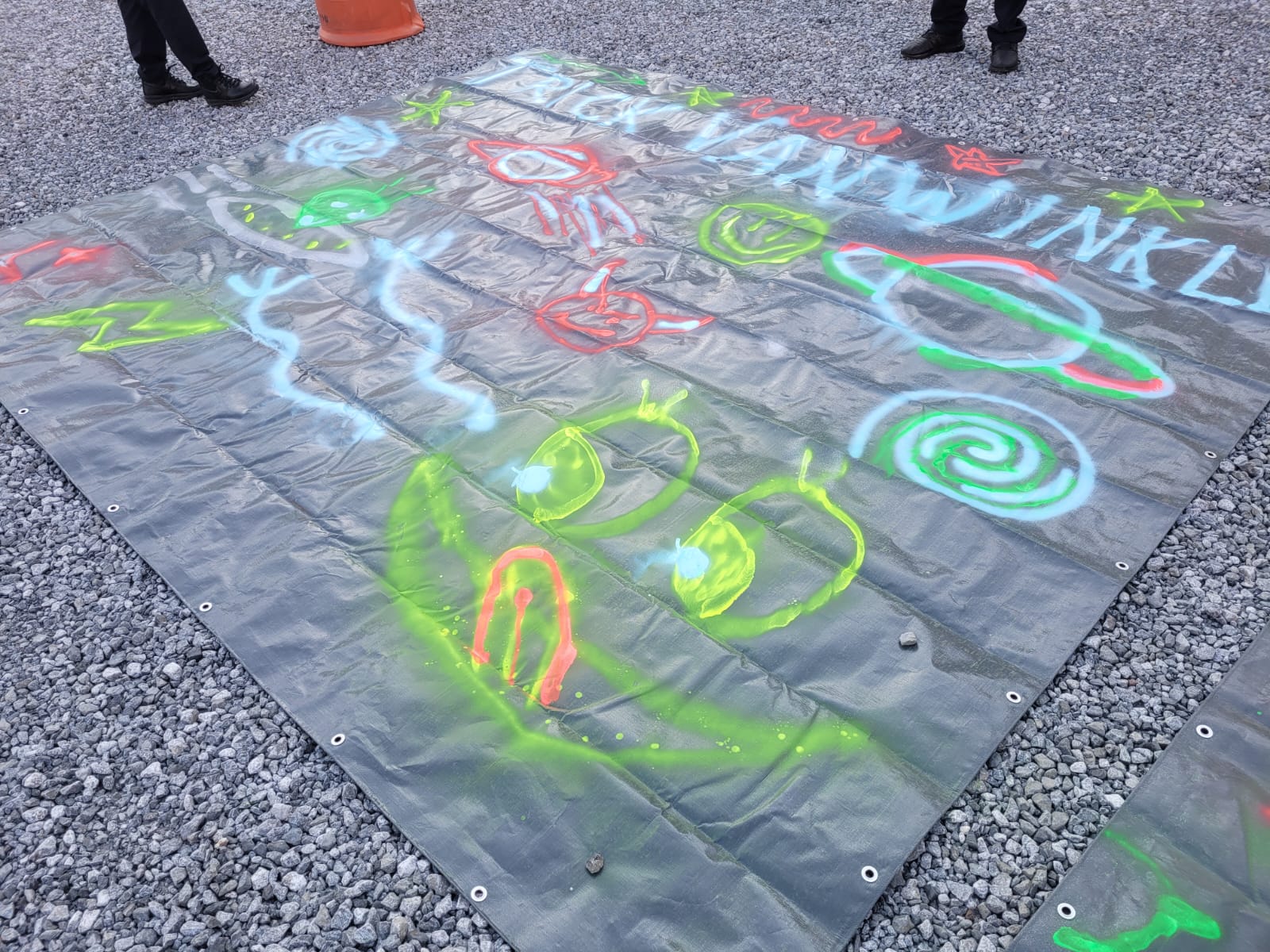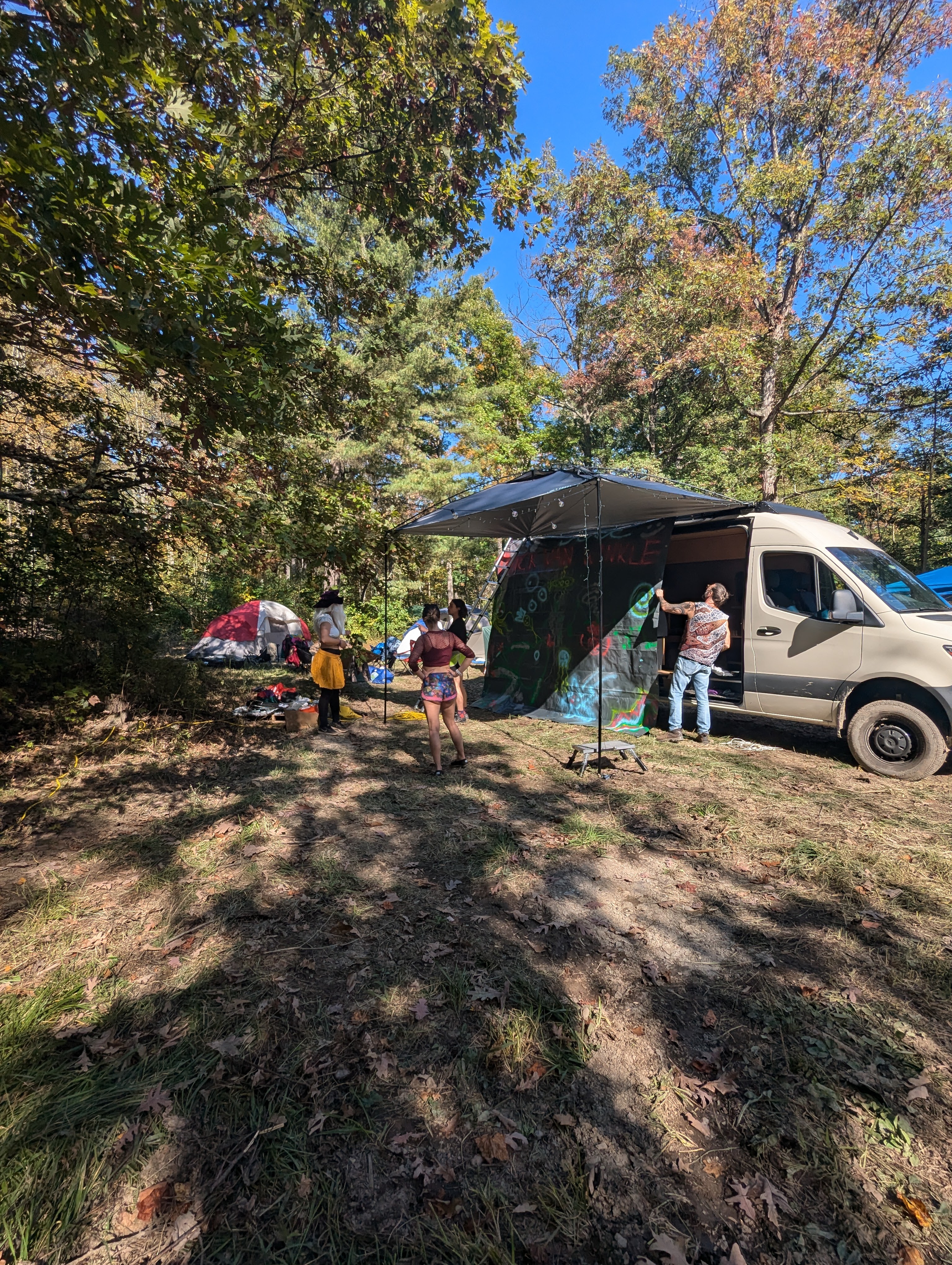
TRICK VAN WINKLE
A magical trickster oasis hidden deep in the Pennsylvania woods at Constellation Burn, featuring an art car, interactive performance, custom-built stage, and woodland dance floor
Project Overview
Timeline
2-3 weeks (planning and execution)
Context
Interactive art installation for Constellation Burn (regional Burning Man)
Team
Collaborative effort with a small group of friends
Location
Forest setting in rural Pennsylvania
Unique performances shared by participants in exchange for magical beverages
Art car, stage, dance floor, DJ booth, lighting rig, power setup, and bar
Built primarily from reclaimed pallets, tarps, and repurposed materials
Total duration of the installation during the Constellation Burn event
"Trick VAN Winkle" was an immersive, participatory art installation created for Constellation Burn, a regional Burning Man event in Pennsylvania. Hidden deep in the woods, our installation featured a graffiti-covered art car, a handcrafted performance stage, woodland dance floor, and a trickster-themed interactive experience. Visitors were invited to share their best "trick" on our stage in exchange for a magical beverage, becoming active participants in the folklore we created rather than passive observers.
Concept Development
The "Trick VAN Winkle" concept emerged from our desire to create an experience that would blend storytelling, participation, and celebration in the spirit of Burning Man principles. We wanted to transform the traditional DJ/dance party into something more meaningful and memorable by adding elements of exchange, performance, and mythic narrative.
Our conceptual foundation was built around a playful reimagining of the Rip Van Winkle folk tale, transformed into a narrative about mysterious trickster creatures who dwell in the Pennsylvania woods. These woodland beings (us) would emerge to share magical potions and music with humans brave enough to visit their domain and share a trick or talent.
The project was designed around several core Burning Man principles: Radical Participation by moving beyond the passive audience/performer divide, creating an Immersive Environment with consistent aesthetic and narrative elements, embracing Gift Economy principles by offering drinks and experience freely, and achieving Transformation by converting ordinary objects into magical elements through creative reimagining.
The Trickster Theme
We chose the trickster archetype (found across world mythologies from Loki to Coyote to Anansi) as our guiding concept because it embodied the playful, boundary-crossing spirit we wanted to evoke. Tricksters challenge conventional wisdom, invert hierarchies, and create both chaos and creativity - perfectly aligned with the transformative ethos of Burning Man culture.
The Exchange Economy
Rather than simply giving away drinks, we created a non-monetary exchange system where visitors would "pay" with creativity and vulnerability by performing on our stage. This created meaningful connections and memorable moments while disrupting the typical consumer/provider relationship found in conventional nightlife settings.
Planning & Design Process
With only 2-3 weeks to conceptualize and execute the entire project, our process needed to be efficient, resourceful, and adaptable. We developed the installation through collaborative ideation, rapid prototyping, and creative problem-solving:
Concept Development & Theme
Our first step was developing a compelling concept that would be both achievable and impactful. We brainstormed various themes before settling on the "Trick VAN Winkle" concept, which cleverly incorporated our primary asset (the van) while creating a rich narrative framework.
Spatial Planning & Resource Assessment
We assessed our available resources (the van, tools, reclaimed materials) and mapped out the spatial requirements for our installation. This included planning the layout within the forest setting, determining power needs, measuring the footprint for the stage and dance floor, and creating a material acquisition list.
Collaborative Division of Labor
With limited time, we strategically divided responsibilities among team members according to skills and interests. We created focused workstreams for van decoration, stage construction, lighting design, power setup, bar menu development, and performance facilitation.
Material Acquisition & Transformation
We sourced materials through creative means - collecting discarded pallets for the stage, acquiring tarps for weather protection and decoration, salvaging lighting equipment, and borrowing power equipment. Each element was then transformed through customization, painting, and modification to align with our trickster aesthetic.


Budget Breakdown & Resource Allocation
Our installation consisted of three main components, each with dedicated teams and budgets:
- Music Setup: $170.27 total ($11.35 per team member) - Included generator, speakers, controllers, lighting, and DJ equipment
- Trick Stage: $660.83 total ($44.06 per team member) - Included stage materials, lighting, costumes, and all beverages for our "magical potions"
- Van Decoration: $239.24 total ($15.95 per team member) - Included tarps, spray paint, cable ties, tape, and lighting elements
By distributing costs across the entire team and sourcing many materials through upcycling, we created a substantial installation while keeping individual contributions affordable.
The Build
Constructing the Trick VAN Winkle installation in a forest environment presented unique challenges that required creative solutions and adaptable techniques. Our construction focused on seven key elements that transformed the woodland setting into a magical realm.

Build Challenges
- Creating stable structures on uneven forest ground without permanent foundations
- Weatherproofing electronic equipment in an outdoor environment
- Generating reliable power in a remote location
- Working with limited tools and materials in a time-constrained setting
- Ensuring structural safety for a performance platform
Creative Solutions
- Developed adjustable leveling systems for the stage using modular pallet construction
- Created waterproof housings and protective overhangs for sensitive equipment
- Implemented a hybrid power system combining the van as well as portable generators
- Embraced the constraints through minimalist design and resourceful material reuse
- Installed reinforced supports and tested weight capacity before opening the stage
The Experience
Once completed, Trick VAN Winkle transformed into a living, participatory experience that evolved throughout the Constellation Burn event. Participants would discover our installation through word of mouth or by following the music and lights through the forest, where they'd encounter our "trickster" characters and learn about our creative exchange system.
Memorable Moments:
• Dawn performances that transformed from night revelry to morning meditation as the lighting shifted from artificial to natural
• Spontaneous collaborations between strangers who combined their talents to create unique multi-person performances
• The moment when our installation reached capacity during peak hours, with the forest clearing filled with dancers and a queue of eager performers
Reflection & Takeaways
Trick VAN Winkle exceeded our expectations, transforming from a simple idea into a vibrant, participatory experience that embodied the spirit of Burning Man culture. The project yielded valuable insights applicable to future creative and professional endeavors:
Participation Transforms Experience
The simple act of requiring a performance fundamentally changed the nature of our installation, transforming visitors from passive consumers to active co-creators. This principle has broad applications in experience design, showing how thoughtful participation mechanics can deepen engagement and create more meaningful connections.
Constraints Drive Creativity
Our limited budget, timeline, and available materials forced innovative solutions that ultimately enhanced the project. Rather than seeing these as limitations, we embraced them as creative boundaries that pushed us toward more resourceful and distinctive approaches. This reinforced the value of working within constraints rather than attempting to eliminate them.
Environmental Integration
By working with our forest setting rather than imposing entirely foreign elements upon it, we created an experience that felt magical yet harmonious with its surroundings. This approach to environmental design—respecting and enhancing existing contexts rather than overwhelming them—proved highly effective and transferable to other design scenarios.
Collaborative Efficiency
Our small team accomplished an ambitious project in minimal time by leveraging individual strengths, maintaining clear communication, and establishing a shared vision that guided independent work streams. This experience reinforced valuable principles of effective collaboration that translate directly to professional project management.
Beyond these specific insights, the project reinforced the power of temporary, transformative experiences. For a brief time, we created a world with its own rules, aesthetic, and culture—a reminder that even small-scale creative interventions can meaningfully impact how people interact with each other and their environment.
The skills developed and showcased through this project—rapid prototyping, environmental adaptation, creative problem-solving, experience design, and collaborative construction—have direct applications across design disciplines and demonstrate the ability to execute complex, multi-faceted projects under constraints.
